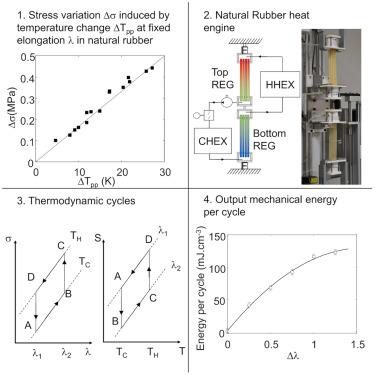Converting low-grade heat into mechanical energy using a natural rubber elastocaloric device
IF 35.4
1区 材料科学
Q1 CHEMISTRY, PHYSICAL
引用次数: 0
Abstract
This work leverages the thermomechanical properties of natural rubber, an abundant, low-cost, and renewable material, for low-grade heat energy harvesting. Natural rubber tubes exhibited temperature-induced stress variations of 10 kPa.K−1 when pre-elongated to 5 times their original length, for a temperature range of 20°C to 60°C. A prototype elastocaloric device was evaluated using a fluid to cyclically transfer heat from a hot heat exchanger to the natural rubber and then to a cold heat exchanger. Constitutive equations and simulations were used to assess the energy conversion capability. Finally, thermodynamic energy cycles were experimentally tested with temperature variations of 35 K and elongations of 4.5–5.5 times the original length, converting heat-to-mechanical work at 4 J per cycle, corresponding to 150 mJ.cm−3. The proposed design is scalable with a larger quantity of natural rubber, and after adding an electromagnetic system, low-grade heat energy may be converted into electricity.


利用天然橡胶弹性热装置将低品位的热能转化为机械能
这项工作利用了天然橡胶的热机械特性,这是一种丰富的、低成本的、可再生的材料,用于低品位的热能收集。天然橡胶管表现出10 kPa的温度诱导应力变化。温度范围为20℃~ 60℃,预拉长至原长度的5倍时,K−1。利用流体循环将热量从热交换器传递到天然橡胶,然后再传递到冷热交换器,对原型弹性热交换器进行了评估。利用本构方程和仿真对能量转换能力进行了评估。最后,在温度变化为35 K,拉伸长度为原长度的4.5-5.5倍的条件下,对热力学能量循环进行了实验测试,每循环以4 J的速度将热量转化为机械功,相当于150 mJ.cm−3。所提出的设计具有可扩展性,可以使用更多的天然橡胶,并且在加入电磁系统后,可以将低品位的热能转换为电能。
本文章由计算机程序翻译,如有差异,请以英文原文为准。
求助全文
约1分钟内获得全文
求助全文
来源期刊

Joule
Energy-General Energy
CiteScore
53.10
自引率
2.00%
发文量
198
期刊介绍:
Joule is a sister journal to Cell that focuses on research, analysis, and ideas related to sustainable energy. It aims to address the global challenge of the need for more sustainable energy solutions. Joule is a forward-looking journal that bridges disciplines and scales of energy research. It connects researchers and analysts working on scientific, technical, economic, policy, and social challenges related to sustainable energy. The journal covers a wide range of energy research, from fundamental laboratory studies on energy conversion and storage to global-level analysis. Joule aims to highlight and amplify the implications, challenges, and opportunities of novel energy research for different groups in the field.
 求助内容:
求助内容: 应助结果提醒方式:
应助结果提醒方式:


